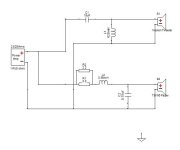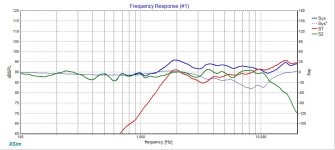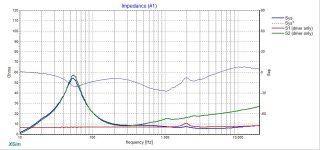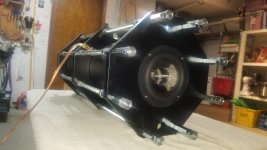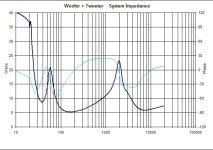I am looking for advice with crossover design. I am attempting to rebuild a set of Cerwin-Vega! L7 Bookshelf speakers. I have decided to use the following drivers:
Visaton SC5-8 Shielded 1/2" Polycarbonate Tweeter 8 Ohm.
Tang Band W5-2143 5" Paper Cone Full Range Driver 8 Ohm.
The enclosure volume is 0.44 cubic feet or 12.4 liters. I am reusing the existing port (1.69” x5" cut down to 3"). I am stuck with the 0.44 cubic feet as I don’t want to cut open the boxes.
I have been experimenting with Xsim for designing the crossover but have a couple concerns, mainly around the impedance curves. I am not sure what is going with the impedance curve for the Tang Band W5 driver, it has a massive spike at around 54 ohms. Nothing seems to smooth it out and I am wondering it this has any potential ramifications to harm my amp or the speaker itself.
Andy help would be greatly appreciated. I have attached a couple images from Xsim.
Visaton SC5-8 Shielded 1/2" Polycarbonate Tweeter 8 Ohm.
Tang Band W5-2143 5" Paper Cone Full Range Driver 8 Ohm.
The enclosure volume is 0.44 cubic feet or 12.4 liters. I am reusing the existing port (1.69” x5" cut down to 3"). I am stuck with the 0.44 cubic feet as I don’t want to cut open the boxes.
I have been experimenting with Xsim for designing the crossover but have a couple concerns, mainly around the impedance curves. I am not sure what is going with the impedance curve for the Tang Band W5 driver, it has a massive spike at around 54 ohms. Nothing seems to smooth it out and I am wondering it this has any potential ramifications to harm my amp or the speaker itself.
Andy help would be greatly appreciated. I have attached a couple images from Xsim.
Attachments
A few questions/comments:
Geoff
- have you used measurements in box or used manufacturers' data? If the latter, it won't generally give optimal results. I recall from somewhere that Tang Band's published measurements of some of its drivers may not be as accurate as other brands.
- have you bought the drivers or just considering what to buy? How did you choose them? The L7 looks like a 7" two way design, so a 5" driver will require a new baffle.
- If this is the case, why not look for an existing two way project with a 6" or 7" woofer which would work in that enclosure?
- my understanding is that resistors in line with a mid or woofer - e.g. to try to reduce its output - are not a good idea due to heat build up, but I'm happy to be corrected
- just looking at what you've provided, it will probably be a bright sounding speaker with weak bass.
Geoff
Last edited:
Edit: I can't find the specs and dimensions for the woofer, it's stated as "7" in various EBay and online retailers: quite cheap, one was about US$25 used.
There are probably a few woofers which could work in that cabinet - depending whether you want to go sealed or vented and what you're after sound wise. For example, off the top of my head, a two way design with the Dayton DC160 might work; most projects which use it are about 15 litres. Not sure about whether the port dimensions would work for it.
Geoff
There are probably a few woofers which could work in that cabinet - depending whether you want to go sealed or vented and what you're after sound wise. For example, off the top of my head, a two way design with the Dayton DC160 might work; most projects which use it are about 15 litres. Not sure about whether the port dimensions would work for it.
Geoff
Geoff,
The Parts-Express product page for the DC-160 mentions that with a 0.43 cu Ft enclosure, the F3 will come to 43 Hz - not bad. Will need to check the port dimensions though.
GeoWorx DIY,
With a wide-band driver like the TB W5-2143, there should be adequate top end to use it without an additional tweeter, thus reducing cost of the tweeters and the cross over parts. The TB-2143 costs quite a bot more than similarly sized woofers/mid-woofers.
The Parts-Express product page for the DC-160 mentions that with a 0.43 cu Ft enclosure, the F3 will come to 43 Hz - not bad. Will need to check the port dimensions though.
GeoWorx DIY,
With a wide-band driver like the TB W5-2143, there should be adequate top end to use it without an additional tweeter, thus reducing cost of the tweeters and the cross over parts. The TB-2143 costs quite a bot more than similarly sized woofers/mid-woofers.
Last edited:
According to Parts Express product page, the BR-1 port is 1.5" x 6"; another design which uses the DC160, the Classix II (15l cabinet) , has a 1.5" x 4" port. Not sure what these dimensions mean in comparison with the 1.69" x 3" in the L7 cabinet.
Geoff
Geoff
This is the TB stated frequency response and impedance curve graph, taken from its website.
Looks rather good, but then it's an expensive driver - $100 each from Parts Express. I think there are some builds on this Forum which use this driver without a tweeter.
Will have an optic and post any links, here's one:
https://www.diyaudio.com/community/...nclosure-design-for-tang-band-w5-2143.384236/
No idea how it sounds, of course.
Geoff
That's from resonance. It's a normal feature of a woofer in a sealed box, infinite baffle, etc. In other types of boxes the shape changes, but peaks are still common.a massive spike at around 54 ohms. Nothing seems to smooth it out and I am wondering it this has any potential ramifications to harm my amp or the speaker itself.
Impedance peaks at bass resonances are normally left alone. The components to flatten them are large (expensive), and with modern amplifiers impedance variations like this are rarely an issue. If you want to fix it anyway, you need an LCR series notch filter. Those 3 components go in series, and that group goes in parallel to the driver in question. This type of filter is more commonly used in tweeters to improve crossover performance. With a tweeter, the large rise in impedance can be in the range where the crossover is working, so it makes the crossover less effective. At bass resonance, passive crossover filters are not normally doing much.
https://www.diyaudioandvideo.com/Calculator/SeriesNotchFilter/Help/
If you have a tube amp with high output impedance, large speaker impedance variations can cause frequency response changes, but that's a pretty rare issue.
I've seen people using inexpensive class D amps talk about high impedance issues also, but I have no personal experience with that. And if you do, I'd suggest upgrading the amplifier instead of trying to make the speaker more benign to a poorly designed amplifier.
Last edited:
Ok! Thank you so much for your responses.
In order of responses:
I have no actual measurements or the components I am considering.
I have not purchased any drivers or cross over components, yet.
The current opening is 7.04" (178mm). So I am going to make a new circular "plug" out of 1/2" (12mm) MDF. Then cut the driver opening into that.
Looking at 6 or 7" drivers, the box volume is not sufficient. I used WinISD to play around with several drivers from Parts Express and Madisound.
I don't mind a "bright" speaker set in this case as I have two excellent satellite speakers and a robust subwoofer based on an Epique E180HE-44 7" DVC MMAG Extended Range Subwoofer. Bass is covered, I'm missing good mids and highs.
This is in my garage and if the rebuilds are superior to the satellite speakers in the TV room, they will replace them. Again, bass is covered in this room.
The port dimension is fluid as I can add a port as needed (with some constraints). The WinISD work up with the TB W5 reusing the existing 1.69" dia. port requires shaving a couple inches off the existing tube.
My frequency and impedance curves (.frd, & .zma) came from using FP Graph Tracer for both the TB W5 and the Visaton Tweeter. So, who knows how accurate that is.
If the impedance spike of the TB W5 is not going to be an issues (this speaker should fall off before 54 Hz), then I wont' worry.
These speakers are being powered by a Sony STR-DE925 (110 RMS, Peak 165 watts at 8 ohms, Peak 230 watts at 4 ohms) set at 4 ohms.
My desire to use a full range driver and a tweeter is my attempts to learn how to "program" a crossover. This project is part of a three part process to building a set of 3-way tower speakers.
Step one was a active sub-woofer, step two is designing a set of two-way speakers and learning the art of crossovers. Step three is the design of the 3-way towers.
Attached is the tube based subwoofer I recently completed based on the Epique E180HE-44 7" DVC MMAG Extended Range Subwoofer. (Dimensions 25 3/4" long. OD 7.7" with a volume of 0.59 cubic feet or 16.7 liters). It is reproducing a response down past 30k (audible).
In order of responses:
I have no actual measurements or the components I am considering.
I have not purchased any drivers or cross over components, yet.
The current opening is 7.04" (178mm). So I am going to make a new circular "plug" out of 1/2" (12mm) MDF. Then cut the driver opening into that.
Looking at 6 or 7" drivers, the box volume is not sufficient. I used WinISD to play around with several drivers from Parts Express and Madisound.
I don't mind a "bright" speaker set in this case as I have two excellent satellite speakers and a robust subwoofer based on an Epique E180HE-44 7" DVC MMAG Extended Range Subwoofer. Bass is covered, I'm missing good mids and highs.
This is in my garage and if the rebuilds are superior to the satellite speakers in the TV room, they will replace them. Again, bass is covered in this room.
The port dimension is fluid as I can add a port as needed (with some constraints). The WinISD work up with the TB W5 reusing the existing 1.69" dia. port requires shaving a couple inches off the existing tube.
My frequency and impedance curves (.frd, & .zma) came from using FP Graph Tracer for both the TB W5 and the Visaton Tweeter. So, who knows how accurate that is.
If the impedance spike of the TB W5 is not going to be an issues (this speaker should fall off before 54 Hz), then I wont' worry.
These speakers are being powered by a Sony STR-DE925 (110 RMS, Peak 165 watts at 8 ohms, Peak 230 watts at 4 ohms) set at 4 ohms.
My desire to use a full range driver and a tweeter is my attempts to learn how to "program" a crossover. This project is part of a three part process to building a set of 3-way tower speakers.
Step one was a active sub-woofer, step two is designing a set of two-way speakers and learning the art of crossovers. Step three is the design of the 3-way towers.
Attached is the tube based subwoofer I recently completed based on the Epique E180HE-44 7" DVC MMAG Extended Range Subwoofer. (Dimensions 25 3/4" long. OD 7.7" with a volume of 0.59 cubic feet or 16.7 liters). It is reproducing a response down past 30k (audible).
Attachments
Thanks for clarifying your requirements. Have you considered using the Dayton RS180, either the aluminium or paper version?
Parts Express' recommended volumes are 0.25 cu ft (7l) sealed, or 0.45 cu ft (12.7l) vented for both; F3 for the vented cabinets is stated as 59Hz for the paper and 48Hz for the aluminium; both sound great, look great and there are several published projects for either. Those projects use larger cabinets, but as you say you have the deep bass covered, that should be OK. If your baffle width and driver layout is similar to any of those projects you might be able to use the same crossover.
Parts Express uses 'Bass Box Pro", no idea how it compares with Win ISD.
Looking at the spec sheet, the RS180 (any version, they seem to have the same dimensions) might even fit your existing cut out without too much surgery: flush mount cut out is stated as 146mm but the outside diameter is 180.5mm.
There are some Peerless/Tymphany woofers which might suit but as the company is getting out of the DIY market future spares could be an issue.
Although the TB is stated as 'full range' you'll still need a crossover of some kind.
Geoff
Parts Express' recommended volumes are 0.25 cu ft (7l) sealed, or 0.45 cu ft (12.7l) vented for both; F3 for the vented cabinets is stated as 59Hz for the paper and 48Hz for the aluminium; both sound great, look great and there are several published projects for either. Those projects use larger cabinets, but as you say you have the deep bass covered, that should be OK. If your baffle width and driver layout is similar to any of those projects you might be able to use the same crossover.
Parts Express uses 'Bass Box Pro", no idea how it compares with Win ISD.
Looking at the spec sheet, the RS180 (any version, they seem to have the same dimensions) might even fit your existing cut out without too much surgery: flush mount cut out is stated as 146mm but the outside diameter is 180.5mm.
There are some Peerless/Tymphany woofers which might suit but as the company is getting out of the DIY market future spares could be an issue.
Although the TB is stated as 'full range' you'll still need a crossover of some kind.
Geoff
Geoff,
Many wide-band aficionados run their drivers without a BSC circuit or contouring circuit; some who try to do say that it can sound better if done properly. 🙂
Many wide-band aficionados run their drivers without a BSC circuit or contouring circuit; some who try to do say that it can sound better if done properly. 🙂
Perhaps 'if done properly' is the key phrase here: the "Sibelius" (commercial and expensive) speakers are well regarded and use a 4" full range driver without any contouring. Then you have something like Curt Campbell's "Singularity" that use a larger full range driver but need a contouring circuit to deal with the driver's peaks etc.
I don't think the Tang Band project on this Forum to which I referred uses such a circuit.
Geoff
I don't think the Tang Band project on this Forum to which I referred uses such a circuit.
Geoff
Thank you for your suggestions Geoff. I will look into the Dayton RS180. I looked at the Dayton PS180 and it would not work with my box restraints. I came up with needing two 15" two inch ports!
As for a crossover, I think I will need some "control" to smooth out the sound and the find a good zone to hand off the highs to the tweeter. I'm thinking in the 4-6kHz.
It's all theoretical until I pop some drivers into the boxes.
George
As for a crossover, I think I will need some "control" to smooth out the sound and the find a good zone to hand off the highs to the tweeter. I'm thinking in the 4-6kHz.
It's all theoretical until I pop some drivers into the boxes.
George
GeoWorx DIY,
Do these work for you?
https://www.madisoundspeakerstore.com/hi-vi-woofers-6-7/hi-vi-l6-4r-6-woven-kevlar-cone-4-ohm/
https://www.madisoundspeakerstore.c...hi-vi-l6-6r-6-woven-kevlar-cone-woofer-6-ohm/
Madisound product page says 55 Hz box tuning with 12 liters.
Do these work for you?
https://www.madisoundspeakerstore.com/hi-vi-woofers-6-7/hi-vi-l6-4r-6-woven-kevlar-cone-4-ohm/
https://www.madisoundspeakerstore.c...hi-vi-l6-6r-6-woven-kevlar-cone-woofer-6-ohm/
Madisound product page says 55 Hz box tuning with 12 liters.
Zman01, I did not investigate these, but I did look at them. The 4 and 6 ohm rating screened them out. I am attempting to keep my speakers 8 ohm to be consistent.
Responding to Geoff's suggestion about using the Dayton RS180-8 7 inch. The sensitivity is listed at 87.1 dB and the tweeter I am considering (because it fits the current opening) is listed at 90 dB (Visaton SC5-8 Shielded 1/2" polycarbonate 8 ohm).
Will I need additional circuitry to math the sensitivity, or will they be close enough?
Will I need additional circuitry to math the sensitivity, or will they be close enough?
The stated dB of the RS180 - or any woofer, for that matter - should be taken as a guide, measured under the maker's conditions. When you put the woofer in a cabinet, my understanding is that several dB will be lost due to 'baffle step' issues. Others can explain that much better than me!
Tweeters are almost always more efficient than woofers and need to be padded down in the crossover, e.g. with resistors. With the RS180 (paper or aluminium) the crossover will generally be around 2,000 Hz and the nasties in their response need to be successfully dealt with in the crossover. For example, see how Paul Carmody deals with those issues in his well known 'Amiga' two ways:
https://sites.google.com/site/undefinition/floorstanding-speakers/amiga
Geoff
Tweeters are almost always more efficient than woofers and need to be padded down in the crossover, e.g. with resistors. With the RS180 (paper or aluminium) the crossover will generally be around 2,000 Hz and the nasties in their response need to be successfully dealt with in the crossover. For example, see how Paul Carmody deals with those issues in his well known 'Amiga' two ways:
https://sites.google.com/site/undefinition/floorstanding-speakers/amiga
Geoff
GeoWorx DIY,
Using an 8 Ohm woofer will not automatically guarantee and minimum impedance of 8 Ohms... it will depend on the drivers and the crossover design you end up doing.
An example of a speaker impedance curve with an 8 Ohm (nominal) woofer and a 4 Ohm tweeter attached. A 4 Ohm woofer would bring the impedance even lower though...
As long as the tweeter is higher sensitivity, you can pad it down easily using a resistor. And a woofer with 87 dB measured on a IEC standard baffle will not be the same with a 8"-9" baffle of a cabinet. You will have to factor in the baffle step loss, which might be 3-6 dB... so it is more likely you might be getting 83-84 dB sensitivity and will have to reduce the tweeter output accordingly.
Using an 8 Ohm woofer will not automatically guarantee and minimum impedance of 8 Ohms... it will depend on the drivers and the crossover design you end up doing.
An example of a speaker impedance curve with an 8 Ohm (nominal) woofer and a 4 Ohm tweeter attached. A 4 Ohm woofer would bring the impedance even lower though...
As long as the tweeter is higher sensitivity, you can pad it down easily using a resistor. And a woofer with 87 dB measured on a IEC standard baffle will not be the same with a 8"-9" baffle of a cabinet. You will have to factor in the baffle step loss, which might be 3-6 dB... so it is more likely you might be getting 83-84 dB sensitivity and will have to reduce the tweeter output accordingly.
Attachments
Last edited:
- Home
- Loudspeakers
- Multi-Way
- New Builder Looking for Crossover Design Help: 2 Way Bookshelf
